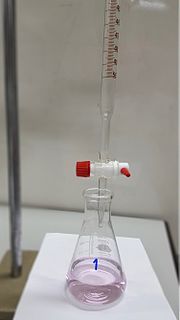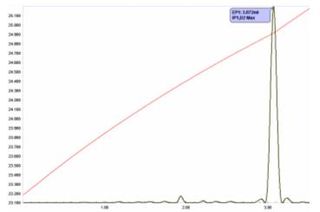
A carboxylic acid is an organic acid that contains a carboxyl group (C(=O)OH) attached to an R-group. The general formula of a carboxylic acid is R−COOH or R−CO2H, with R referring to the alkyl, alkenyl, aryl, or other group. Carboxylic acids occur widely. Important examples include the amino acids and fatty acids. Deprotonation of a carboxylic acid gives a carboxylate anion.

Titration is a common laboratory method of quantitative chemical analysis to determine the concentration of an identified analyte. A reagent, termed the titrant or titrator, is prepared as a standard solution of known concentration and volume. The titrant reacts with a solution of analyte to determine the analyte's concentration. The volume of titrant that reacted with the analyte is termed the titration volume.
A primary standard in metrology is a standard that is sufficiently accurate such that it is not calibrated by or subordinate to other standards. Primary standards are defined via other quantities like length, mass and time. Primary standards are used to calibrate other standards referred to as working standards. See Hierarchy of Standards.

Phthalic acid is an aromatic dicarboxylic acid, with formula C6H4(CO2H)2. It is an isomer of isophthalic acid and terephthalic acid. Although phthalic acid is of modest commercial importance, the closely related derivative phthalic anhydride is a commodity chemical produced on a large scale. Phthalic acid is one of three isomers of benzenedicarboxylic acid, the others being isophthalic acid and terephthalic acid.

Jean Baptiste André Dumas was a French chemist, best known for his works on organic analysis and synthesis, as well as the determination of atomic weights and molecular weights by measuring vapor densities. He also developed a method for the analysis of nitrogen in compounds.

Saponification value or saponification number represents the number of milligrams of potassium hydroxide (KOH) or sodium hydroxide (NaOH) required to saponify one gram of fat under the conditions specified. It is a measure of the average molecular weight of all the fatty acids present in the sample as triglycerides. The higher the saponification value, the lower the fatty acids average length, the lighter the mean molecular weight of triglycerides and vice-versa. Practically, fats or oils with high saponification value are more suitable for soap making.
Coulometry determines the amount of matter transformed during an electrolysis reaction by measuring the amount of electricity consumed or produced. It can be used for precision measurements of charge, and the amperes even used to have a coulometric definition. However, today coulometry is mainly used for analytical applications. Coulometry is a group of techniques in analytical chemistry. It is named after Charles-Augustin de Coulomb.

Acetic anhydride, or ethanoic anhydride, is the chemical compound with the formula (CH3CO)2O. Commonly abbreviated Ac2O, it is the simplest isolable anhydride of a carboxylic acid and is widely used as a reagent in organic synthesis. It is a colorless liquid that smells strongly of acetic acid, which is formed by its reaction with moisture in the air.

Acetyl chloride (CH3COCl) is an acyl chloride derived from acetic acid. It belongs to the class of organic compounds called acid halides. It is a colorless, corrosive, volatile liquid. Its formula is commonly abbreviated to AcCl.
Equivalent weight is the mass of one equivalent, that is the mass of a given substance which will combine with or displace a fixed quantity of another substance. The equivalent weight of an element is the mass which combines with or displaces 1.008 gram of hydrogen or 8.0 grams of oxygen or 35.5 grams of chlorine. These values correspond to the atomic weight divided by the usual valence; for oxygen as example that is 16.0 g / 2 = 8.0 g.
The iodine value in chemistry is the mass of iodine in grams that is consumed by 100 grams of a chemical substance. Iodine numbers are often used to determine the amount of unsaturation in fats, oils and waxes. In fatty acids, unsaturation occurs mainly as double bonds which are very reactive towards halogens, the iodine in this case. Thus, the higher the iodine value, the more unsaturations are present in the fat. It can be seen from the table that coconut oil is very saturated, which means it is good for making soap. On the other hand, linseed oil is highly unsaturated, which makes it a drying oil, well suited for making oil paints.
Acid value is the mass of potassium hydroxide (KOH) in milligrams that is required to neutralize one gram of chemical substance. The acid number is a measure of the number of carboxylic acid groups in a chemical compound, such as a fatty acid, or in a mixture of compounds. In a typical procedure, a known amount of sample dissolved in an organic solvent and titrated with a solution of alcoholic potassium hydroxide (KOH) of known concentration using phenolphthalein as a colour indicator.
The Sørensen formol titration(SFT) invented by S. P. L. Sørensen in 1907 is a titration of an amino acid with potassium hydroxide in the presence of formaldehyde. It is used in the determination of protein content in samples.
Bromine number is the amount of bromine in grams absorbed by 100 grams (3.5 oz) of a sample. The number indicates the degree of unsaturation.
In analytical chemistry, quantitative analysis is the determination of the absolute or relative abundance of one, several or all particular substance(s) present in a sample.
The total acid number (TAN) is a measurement of acidity that is determined by the amount of potassium hydroxide in milligrams that is needed to neutralize the acids in one gram of oil. It is an important quality measurement of crude oil.

A thermometric titration is one of a number of instrumental titration techniques where endpoints can be located accurately and precisely without a subjective interpretation on the part of the analyst as to their location. Enthalpy change is arguably the most fundamental and universal property of chemical reactions, so the observation of temperature change is a natural choice in monitoring their progress. It is not a new technique, with possibly the first recognizable thermometric titration method reported early in the 20th century. In spite of its attractive features, and in spite of the considerable research that has been conducted in the field and a large body of applications that have been developed; it has been until now an under-utilized technique in the critical area of industrial process and quality control. Automated potentiometric titration systems have pre-dominated in this area since the 1970s. With the advent of cheap computers able to handle the powerful thermometric titration software, development has now reached the stage where easy to use automated thermometric titration systems can in many cases offer a superior alternative to potentiometric titrimetry.
Total Base Number (TBN) is a measurement of basicity that is expressed in terms of the number of milligrams of potassium hydroxide per gram of oil sample. TBN is an important measurement in petroleum products, and the value varies depending on its application. TBN generally ranges from 6–8 mg KOH/g in modern lubricants, 7–10 mg KOH/g for general internal combustion engine use and 10–15 mg KOH/g for diesel engine operations. TBN is typically higher for marine grade lubricants, approximately 15-80 mg KOH/g, as the higher TBN values are designed to increase the operating period under harsh operating conditions, before the lubricant requires replacement.
The term "Lignin characterization" refers to a group of activities within lignin research aiming at describing the characteristics of a lignin by determination of its most important properties. Most often, this term is used to describe the characterization of technical lignins by means of chemical or thermo-chemical analysis. Technical lignins are lignins isolated from various biomasses during various kinds of technical processes such as wood pulping. The most common technical lignins include lignosulphonates, kraft lignins, organosolv lignins, soda lignins and lignin residue after enzymatic treatment of biomass.
Amine value is a measure of the nitrogen content of an organic molecule. Specifically it is usually used to measure the amine content of amine functional compounds. It may be defined as: the number of milligrams of KOH equivalent to one gram of epoxy hardener resin. The units are thus mg KOH/g.








